9 Mistakes To Avoid With A Tofu Press
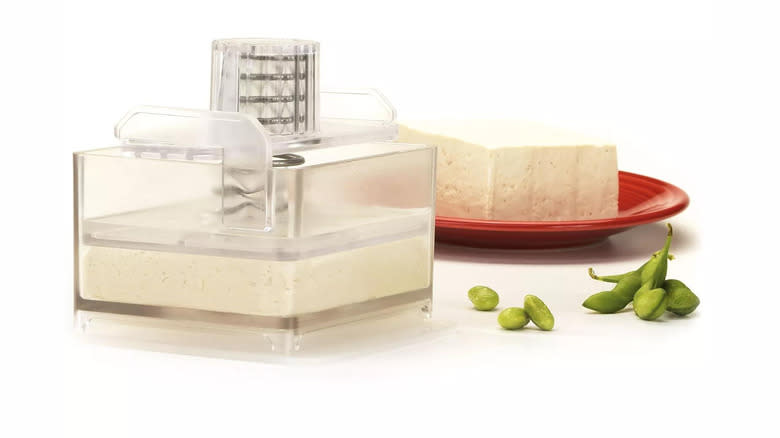
Tofu is one of the strangest foods around. It's a neutrally flavored, spongy block that intimidates even experienced chefs. Preparing it is deceptively simple, but if you mess up, you'll be left with a flavorless block of mush. One mistake that many folks make is approaching tofu like meat. Tofu has a unique consistency that requires a unique approach. You can't simply sprinkle it with seasoning and expect it to taste like a savory steak. If you're looking to replicate the taste and texture of your favorite meats, there are some important steps you need to follow.
Arguably, one of the most important and often overlooked steps in preparing delicious tofu is pressing out the water. Most store-bought tofu comes in a plastic container filled with water, which is partly absorbed by the spongy block. The water helps preserve the tofu but should be removed before cooking. Otherwise, the moisture dilutes the intensity of seasoning and leads to bland results.
The best way to drain water from tofu is with a press. A tofu press is a cheap kitchen tool made specifically for removing excess water. This will make the block less likely to fall apart, which will, in turn, make it easier to flavor and develop the perfect crispy skin. Step up your stir fry by avoiding these common tofu press mistakes.
Read more: 21 Delicious Ways To Use Up Leftover Rice
Not Cleaning Your Press After Each Use
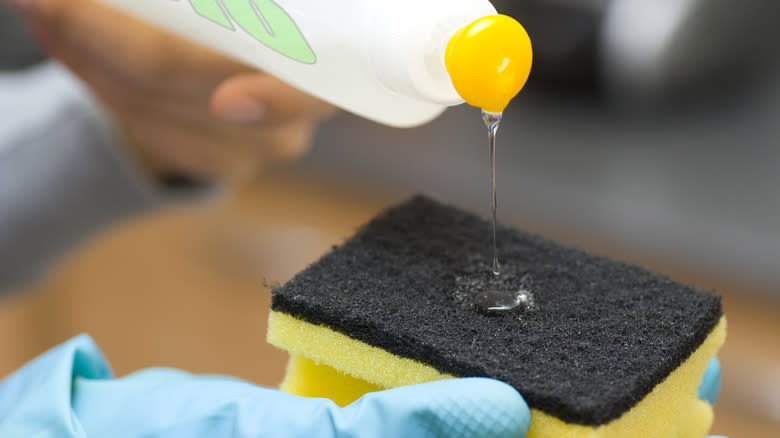
It's important to properly maintain your tofu press. The cleaning method that you should use depends on the type of press. Presses can be made of plastic, bamboo, and stainless steel and come in several different styles that apply pressure differently. Make sure to read the instruction manual carefully before attempting to clean it so that you can choose the best method for your press. For most presses, maintenance and cleaning is pretty straightforward, so long as you keep a few things in mind. After each use, wash your press with warm, soapy water to remove any tofu bits or residue. Doing so will prevent bacteria growth and ensure that you can press tofu for years to come.
When you finish washing the press, disinfect it with a 1-to-1 ratio of vinegar and water and dry it off before putting it away. If it's been some time since you've used your press, consider giving it a deep clean. Box-style tofu presses made of plastic can soak in cleaning solution for up to 15 minutes. You can disassemble screw-style presses and wash the individual parts with a combination of ½ cups of warm water and ½ cups of vinegar.
Pressing The Wrong Type Of Tofu
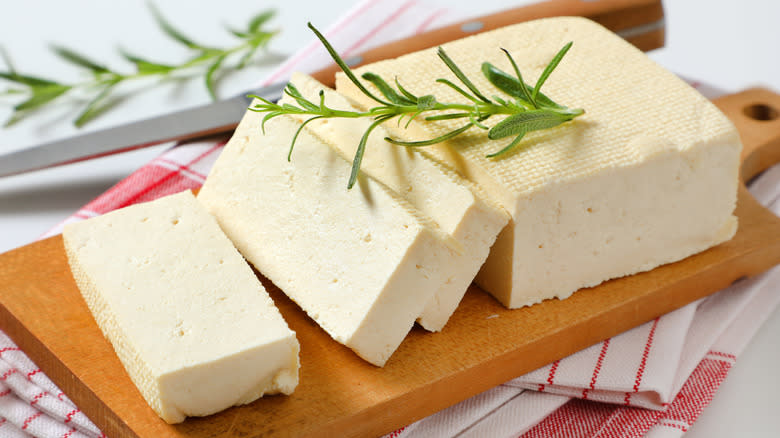
Tofu can vary in firmness. Silken tofu has the softest consistency, and then there's medium, firm, extra firm, and super firm. Tofu presses are mostly made for firm and extra-firm varieties because they have a consistency that can withstand pressure. Super firm tofu has a really low moisture content, so pressing it isn't necessary. Medium-firm tofu can be pressed but should generally be avoided because you don't want the block to fall apart.
Tofu is usually found in the produce section of the grocery store. Most store-bought tofu brands come in a 14 or 16-ounce plastic container and are within the same affordable price range, at around a few dollars for a block. You're likely to also come across pre-pressed tofu in a waterless vacuum seal. It's a great alternative if you're short on time. Some even come pre-seasoned and ready to incorporate into recipes at home.
Putting Cold Tofu Into Your Press
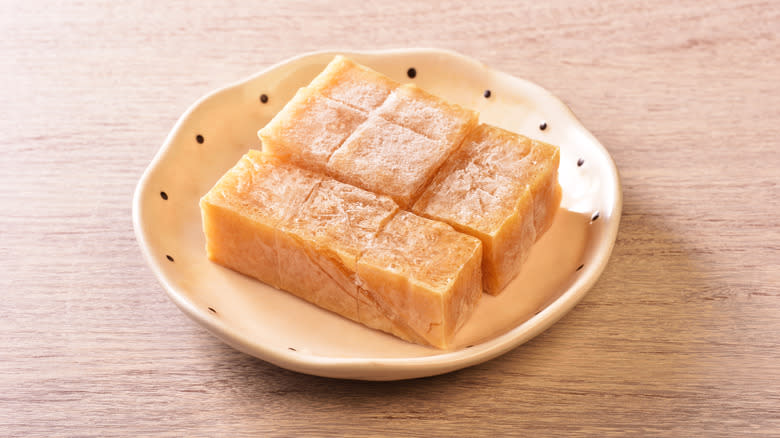
Temperature can impact how well the water drains from the tofu. When stored in a fridge or freezer, the tofu will more readily hold in the water around it. Always let tofu warm to room temperature before using a presser. The tofu becomes less dense as it thaws, and water becomes easier to remove.
Frozen tofu is another story. The cold conditions of your freezer will cause the water to expand in the tofu block. As the ice melts into water, tiny holes are left behind due to expansion. It gives the tofu a meat-like and extra spongy texture. Plus, the tofu will have greater porosity and better absorb sauces and marinades. In general, pre-frozen tofu soaks up liquids better than regular fridge-stored ones. Advantages aside, both storage options can help to simplify pressing, which can make recipes like this tom yum soup even more flavorful.
Forgetting To Pre-Cut Your Tofu
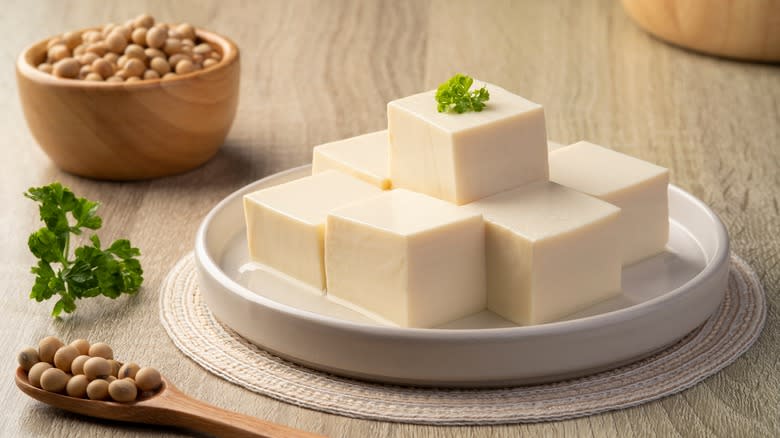
Firm tofu is called firm for a reason; it has a sturdier structure that doesn't give easily under pressure. While most tofu presses are designed specifically to fit a single block, there's an additional step that can help lighten the workload of pressing it. If you cut your tofu into slices, you can apply pressure to them individually. Some recommended it over pressing the whole block, which can take anywhere from 30 to 60 minutes to drain.
The best way to section your tofu is by slicing it horizontally or diagonally. One-inch thick slices should yield about three to four individual tofu slabs, depending on the size of the block. Slicing tofu into pieces helps it maintain its shape while it's pressed and extract water more effectively. That saves you time in the long run and alleviates the pressure of perfectly pressing your tofu (pun intended).
Over-Tightening And Overpressing Your Tofu

It may seem counterintuitive, but there is such a thing as over-tightening your tofu press. After all, some tofu dishes benefit from a little moisture. Tofu scrambles are a great example. These scrambled egg-like dishes are a popular choice for tofu newbies and lifelong vegans alike. Leaving a bit of moisture will give your tofu a soft and fluffy consistency, thereby making it easier to scramble into juicy egg-like crumbles. Medium, firm, and extra firm are the best types of tofu to use when making a scramble because they all contain just enough moisture to achieve the perfect texture.
Rubbery scrambles are the last thing you want on your breakfast plate. That said, an over-pressed tofu scramble with a dry taste is just as unappealing. You should still feel some slickness when you touch the tofu, but if it feels sticky, then you've more than likely over-pressed it. To be on the safe side, we recommend pressing it for only five minutes. Once you've got it down, you can use an array of common kitchen staples to season your tofu and make it into a delicious, savory breakfast.
Neglecting To Adjust The Pressure On Your Tofu Press

Tofu presses must be adjusted to the thickness of the block you are using. Some presses use a spring or screw function, and others use an adjustable silicone band to apply pressure. There are also manually operated handheld tofu presses.
The amount of pressure you apply to the press depends on the recipe and the type of tofu you're using. Rather than starting with maximum pressure, which can blemish your block and damage your press, adjust it until you feel resistance. When using a screw-style plate press on firm or extra firm tofu, start with subtle pressure and increase the tightness every five minutes — for 15 minutes to an hour, or until it's water-free.
Another way to remove water from extra firm tofu is to flip the block over and press it again. Dryness is essential if you plan on roasting tofu, but it's important for other cooking applications as well. That said, you don't have to press it for an hour to enjoy deliciously tasty tofu; a good 30-minute squeeze should be sufficient for most recipes. You can put a healthy plant-based spin on a classic with tofu pad Thai, or if you prefer something richer, try baked General Tso's tofu.
Not Pressing The Tofu For Long Enough

Sometimes tofu must be pressed for a long time to reach the perfect consistency. While it's commonly suggested that you should press tofu for at least 30 minutes, that may be insufficient depending on the type of tofu you're using and the dish you're making. If you find it challenging to achieve the firm consistency you want, or you find yourself consistently ending up with flavorless tofu, there's a good chance you aren't pressing it long enough. Try increasing the drain time to an hour for a more thorough press. If you want super dry tofu, you can even press it for up to four hours.
You'll have to be patient as your tofu presses -- but the wait is totally worth it. If you don't have four hours' worth of patience, you can place tofu in a microwave to drain moisture faster. If you choose the latter, wrap the block in a paper towel or a clean kitchen towel first. You'll need a microwave-safe rimmed plate that can capture the liquid. Microwave the tofu in 30-second bursts, and be sure to keep an eye on it to prevent overcooking it. After you're satisfied, take another paper towel and dry any remaining moisture on the block's surface, and you're good to go.
Forgetting To Line The Inside Of Your Box Press

There are additional steps required to use a box-style tofu press effectively. Unlike other press varieties, box-style presses are enclosed, meaning that the tofu tends to stick against the sides. Sticking can crumble the tofu when you try to remove it, and if you're a stickler for flawless squares, that's the last thing you want. Fortunately, it's easy to avoid. Simply place parchment paper or a clean kitchen towel along the bottom of your press before you place your slice or block in.
This hack prevents sticking and simplifies the cleaning process. You can remove tofu debris in an instant and rinse out your press in even less time. Try not to use too much parchment because bunches will push against the tofu and compromise its structure. Kitchen towels are easier to manage overall, but both can get the job done.
Not Using A Plate To Collect The Excess Water

While some tofu presses come equipped with a tray or container for excess water, cheaper models must be positioned properly so the water can fully drain. You can position a plate press with screws vertically on a rimmed plate to collect the runoff. This method makes it easy to dispose of after you finish pressing the block. You can use plastic storage containers, wide bowls, or similar kitchenware, along with rimmed plates.
Alternatively, you can use dinner plates as a substitute if you don't own a tofu press. First, wrap the block in a clean kitchen towel and place it on a large, rimmed plate. Next, weigh it down with something heavy and flat, like a pan, then add two to three cans on top for additional pressure. Let it press for 30 minutes or until it reaches your desired consistency.
Read the original article on Tasting Table


